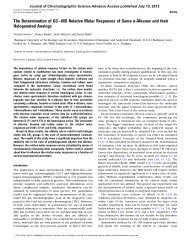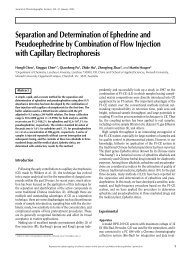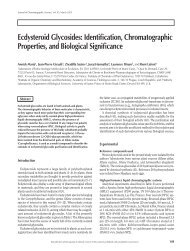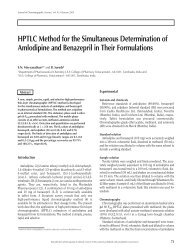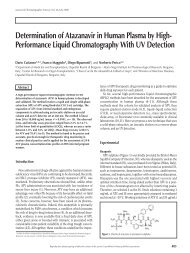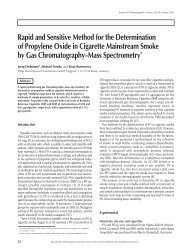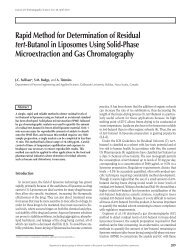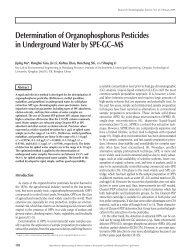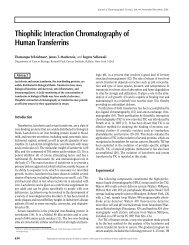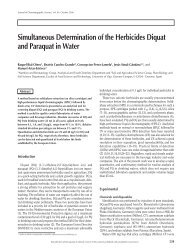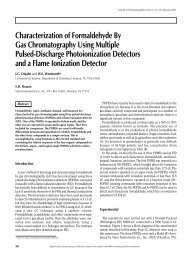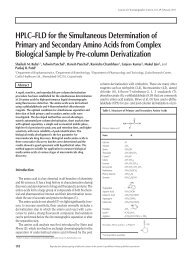Preparative High-Performance Liquid Chromatography–Mass ...
Preparative High-Performance Liquid Chromatography–Mass ...
Preparative High-Performance Liquid Chromatography–Mass ...
You also want an ePaper? Increase the reach of your titles
YUMPU automatically turns print PDFs into web optimized ePapers that Google loves.
<strong>Preparative</strong> <strong>High</strong>-<strong>Performance</strong> <strong>Liquid</strong><br />
<strong>Chromatography–Mass</strong> Spectrometry for the<br />
<strong>High</strong>-Throughput Purification of Combinatorial Libraries<br />
Marcus Bauser*<br />
Medicinal Chemistry VII, Business Group Pharma, BAYER AG, 42096 Wuppertal, Germany<br />
Abstract<br />
Accurate results for the testing of combinatorial libraries<br />
necessitates high purity of the library members. Therefore,<br />
combinatorial libraries derived from a combinatorial solution or<br />
solid-phase synthesis often require the purification of compounds<br />
that do not achieve a certain purity threshold. This study describes<br />
that preparative high-performance liquid chromatography<br />
(HPLC)–mass spectrometry (MS) is the method of choice for the<br />
purification of large arrays of diverse compounds. The adoption of<br />
this technology to the workflow of a solution phase combinatorial<br />
chemistry laboratory producing more than 20,000 compounds per<br />
year is described. Furthermore, the setup and logistics are discussed<br />
as well as the purity achievable for large libraries. Efficiency, speed,<br />
quality, and universality of preparative HPLC–MS are presented in<br />
detail for a library of 140 compounds, including data logistics and<br />
downstream processes as well.<br />
Introduction<br />
Genomics and proteomics provide a unique source of new targets<br />
for many kinds of diseases (1). After a new drugable target is<br />
discovered and an appropriate assay is established, highthroughput<br />
screening (HTS) and nowadays ultra-HTP are the key<br />
technologies for discovering small molecules interacting with<br />
this target (2). These screening technologies have inherently<br />
changed the drug discovery process during the last decade and<br />
have forced chemists to develop strategies for the synthesis of<br />
large numbers of compounds in less time. Consequently, combinatorial<br />
chemistry became popular by promising thousands of<br />
compounds in short time frames. Together with genomics and<br />
proteomics this technique represents a technology platform that<br />
enables scientists to investigate all kinds of diseases on the molecular<br />
level in a fast and efficient manner. Test results can only be as<br />
* Email: Marcus.Bauser.mb@Bayer-ag.de.<br />
292<br />
good as the library tested; therefore, strategies in combinatorial<br />
chemistry have changed tremendously from synthesizing millions<br />
of compounds as mixtures to the parallel synthesis of hundreds<br />
and thousands of distinguished well-characterized<br />
compounds in high purity. One reason for this change for<br />
example was that the deconvolution of large mixtures often failed<br />
or caused severe problems.<br />
The lead finding/refinement process can be described as follows.<br />
The result of an HTS run mostly consists of a set of active<br />
compounds having activity in the submicromolar level. After analytics<br />
the activity of these hits is confirmed in more complex<br />
second line assays as well as in vivo models. This is the starting<br />
point for structural refinement in order to turn the lead compound<br />
into a development candidate. In this step further parameters<br />
such as toxicology and absorption distribution metabolism<br />
excretion parameters have to be optimized. Combinatorial chemistry<br />
plays two major roles in this step. First of all, a diverse library<br />
for initial screening has to be built up. Together with historical<br />
compound collections this is achieved by using high-throughput<br />
combinatorial synthesis. In the second part, the structure activity<br />
relationship (SAR) from singular hits or small hit sets has to be<br />
determined. This is done by synthesizing focused libraries that<br />
cover the diversity around the scaffold of the initial hit. These<br />
combinatorial libraries can either be prepared on solid support (3)<br />
or in solution (4); formats are usually microtiter plates (MTPs) or<br />
related footprints. Automation is used when appropriate, typical<br />
automated steps are sample distribution and reformatting using<br />
liquid handlers. Today, almost all reaction conditions (e.g., reflux,<br />
cooling, and inert atmosphere) can be applied even to large arrays<br />
of compounds. Library design addressing diversity (5) and biophysical<br />
parameters (6) can be applied to virtual libraries for<br />
selecting an optimal subset for synthesis. A must is the availability<br />
of diverse and exclusive educts to cover a diverse chemical space<br />
and produce exclusive unique compounds even by using simple<br />
reaction sequences. As mentioned previously, purity is crucial in<br />
terms of accurate SAR determination, and not too many tools are<br />
available for the purification of libraries. <strong>Liquid</strong>–liquid extraction<br />
is only applicable in cases of high-polar byproducts or excess<br />
Reproduction (photocopying) of editorial content of this journal is prohibited without publisher’s permission.<br />
Journal of Chromatographic Science, Vol. 40, May/June 2002
Journal of Chromatographic Science, Vol. 40, May/June 2002<br />
educts (7), and scavenging with polymeric reagents (8) is strongly<br />
educt-dependent. Chromatography using silica columns also has<br />
disadvantages because the columns are not inert, compounds<br />
Table I. Illustration of the Advantages and Disadvantages<br />
of <strong>Preparative</strong> HPLC Setup as a UV or Mass Triggered<br />
System<br />
<strong>Preparative</strong> HPLC–UV <strong>Preparative</strong> HPLC–MS<br />
Advantageous<br />
Rugged One injection, one fraction<br />
Cheap Identification online<br />
Sharp peak shape Deck capacity not critical<br />
Logistics easy to handle<br />
Disadvantageous<br />
Each peak is a fraction Some samples might be lost<br />
Fraction collector capacity critical Price<br />
Complex logistics Peak broadening<br />
Figure 1. Setup of a preparative HPLC–MS system.<br />
Figure 2. Separation of three compounds in (A) 10- and (B) 50-µmol amounts injected in DMSO.<br />
Figure 3. Typical sample of (A) preparative HPLC–MS chromatographic purification and (B) online identification.<br />
should not be too polar, and complex sample preparation is necessary.<br />
In order to cope with these problems, reversed-phase<br />
chromatography is the method of choice for the purification of<br />
libraries.<br />
<strong>Preparative</strong> high-performance liquid chromatography (HPLC)<br />
has been used for years in peptide (9) and combinatorial chemistry<br />
(10). Columns, buffers, pumps, injectors, fraction collectors,<br />
and software are commercially available from many companies<br />
providing ready-to-use systems. Fraction collection is achieved<br />
using UV detection. Consequently, every UV-active compound can<br />
be collected, and each UV peak above a certain threshold is a fraction.<br />
At the time these instruments were introduced this was<br />
regarded as an advantage and not as a problem, but this turns into<br />
a problem when many samples have to be purified because this<br />
requires complex logistics for product identification and “cherry<br />
picking”. In order to speed up this procedure Kassel et al. (11)<br />
developed online detection and fractionation of target molecules<br />
by using preparative HPLC–mass spectrometry (MS) in the laboratories<br />
of Combichem (San Diego, CA) in which this approach is<br />
successfully used for fast and efficient lead optimization<br />
(12). The main advantage of preparative<br />
HPLC–MS is that only the target molecule is<br />
selected by detecting the ion current of the desired<br />
target molecule. This means that only productcontaining<br />
fractions are identified and collected,<br />
resulting in advantages such as “online” identification,<br />
easy-to-handle logistics, and noncritical<br />
fraction collector capacity. One disadvantageous is<br />
that if for any reason an existing product is not<br />
detected by MS, the sample is lost. Also, because of<br />
splitting and the nature of the MS detector, peak<br />
broadening is sometimes observed. This can lead<br />
to impure samples especially when fast chromatography<br />
is applied. However, there are still<br />
advantages of UV-based systems, such as ruggedness,<br />
price, and the optimal detector behavior in<br />
terms of peak shape. Additionally, these systems<br />
are more or less easy to handle.<br />
This makes UV-based systems the systems of<br />
choice for small libraries and complex separation<br />
problems (see Table I). The biggest advantage of<br />
293
preparative HPLC–MS is the one-injection, one-fraction purification<br />
procedure that solves many logistical problems normally<br />
encountered with large libraries.<br />
In addition to the setup of a standard preparative UV system, an<br />
MS and at least one more pump is needed. These systems are<br />
commercially available from different suppliers (Gilson Abimed,<br />
Figure 4. Downstream process encountered with preparative HPLC–MS<br />
schematically.<br />
294<br />
Figure 5. Purity check of a subset of 140 compounds on each process stage.<br />
Journal of Chromatographic Science, Vol. 40, May/June 2002<br />
Langenfeld, Germany; PerkinElmer, Weiterstadt, Germany;<br />
Shimadzu, Langenfeld, Germany; and Waters, Eschborn,<br />
Germany) and all have their pros and cons. Nevertheless, the<br />
setup is almost the same, which is described schematically in<br />
Figure 1. Differences include the software platforms used and<br />
some of the hardware components.<br />
Experimental<br />
HPLC–MS setup<br />
The setup (shown in Figure 1) consisted of a preparative pump<br />
(Waters LC 4000) generating a gradient flow. This flow was<br />
pumped through a switching valve (Rheodyne, L.P., Rohnert<br />
Park, CA) that allowed two column switchings, thus achieving<br />
optimal throughput by saving time for column conditioning.<br />
After the column, the eluent ran through a UV detector (Waters<br />
2487) and then into a special splitter device (LC packings). This<br />
splitter device diluted the sample by a factor of 1000 using the<br />
flow of pump D (Waters 215) to achieve a concentration suitable<br />
for MS characterization. The remaining preparative flow was<br />
pumped through a valve at the fraction collector (Gilson 215),<br />
which was only triggered when the target mass was determined<br />
to be above a certain threshold. Pump C (Waters 515) was used for<br />
equilibrating one column during the chromatography on the<br />
second column. For running such a system, a few more parameters<br />
have to be checked by comparing with a conventional UVtriggered<br />
system. The HPLC parameters flow rate, pressure,<br />
external pulses, and run time have to be optimized. MS parameters<br />
also have to be edited (e.g., mass or molecular composition of<br />
the target molecule, possible ion adducts and their intensity<br />
thresholds, lens voltages, and scan rates). The MS parameters<br />
have to be carefully evaluated before each run in comparison with<br />
a standard compound in order to ensure that no compound gets<br />
lost because of ion intensity reasons.<br />
HPLC conditions<br />
Two chromatography modes were applied depending on the<br />
chemistry project (a semipreparative setup with the goal of a 10-<br />
µmol product and a preparative setup with the goal of 50 µmol).<br />
Typical results of the chromatography and experimental conditions<br />
for both setups are outlined in Figure 2.<br />
Because a gradient acetonitrile and water was used, all attempts<br />
to use methanol instead of acetonitrile failed mainly because of<br />
back pressure and peak shape. Different reversed-phase materials<br />
were tested, and depending on the physicochemical properties of<br />
the library, hydrophilic-endcapped or standard-endcapped C18<br />
material was used. The particle size was found to be optimal<br />
between 5 and 7 µm, being that it was the best compromise<br />
between the mass loading and theoretical plate height. The 8- ×<br />
75-mm columns for the purification of 10 µmol were run with 12<br />
mL/min and a 5-min 10% to 90% acetonitrile gradient. The 20- ×<br />
50-mm columns for the purification of 100 µmol were run with<br />
40 mL/min and a 5-min 10% to 90% acetonitrile gradient. The<br />
column life time was determined as 500 to 1000 injections<br />
depending on the mixtures injected. Formic acid (0.05%) was<br />
added to the gradient system in order to obtain proper chro-
Journal of Chromatographic Science, Vol. 40, May/June 2002<br />
matography and good ionization of the target molecules in electrospray<br />
ionization (ESI) +/– mode. The lens voltages were optimized<br />
to smooth ionization in order to prevent fragmentation.<br />
This was a prerequisite because the molecular mass was the<br />
target mass for the fractionation. Fragmentation was also the<br />
reason for preferring ESI over atmospheric pressure chemical<br />
ionization (APCI). When using APCI, generally higher fragmentation<br />
was observed. A real sample is shown in Figure 3.<br />
The UV trace as well as the total ion current (TIC) are shown.<br />
Based on the TIC of the target molecule, the fraction collector was<br />
triggered. This demonstrated very well the advantages of preparative<br />
HPLC–MS over preparative HPLC–UV. This example could<br />
lead to at least 8 fractions by collecting every UV-active component<br />
of the reaction mixture.<br />
Logistics and data handling<br />
The whole downstream process is schematically outlined in<br />
Figure 4. As already mentioned, sample logistics can be very userfriendly<br />
with this technology. In a combinatorial synthesis the<br />
molecules are defined by the applied chemistry and the educts<br />
used. This information is usually stored within a suitable database<br />
having all information for the purification process available. The<br />
information for the sample carrier containing the filtered reaction<br />
mixtures can be tracked via this database, and the necessary<br />
information for the preparative HPLC–MS can also be extracted.<br />
Usually, the molecular composition is sufficient. During the<br />
purification process the samples are fractionated into an MTP<br />
format of 24 or 48 wells, respectively (normally one but sometimes<br />
two fractions are obtained from one injection). These fraction<br />
collection plates are evaporated and the fractions redissolved<br />
in dimethylsulfoxide (DMSO). Meanwhile, the MS data is automatically<br />
processed and allows for precise sample tracking in the<br />
collecting plates. This information is transferred into an Excel<br />
VBA-Macro, which transforms the data into a run file for a liquid<br />
handler. The liquid handler pools the samples back into a 96-well<br />
format, and the final results are written into the entire database.<br />
Either 96- or 384-well MTP copies are formed, and the corresponding<br />
data can then be extracted for screening purposes. It is<br />
important to notice that data flow and data management can be a<br />
severe bottleneck in case they are not automated and capable of<br />
carrying all the information and processing the data in every<br />
stage. In summary, the data logistic framework has to store structures<br />
and synthesis information as well as MS data. Besides data<br />
storage the system has to provide run files for liquid handlers and<br />
track this information.<br />
Results<br />
By applying straightforward chemistry many compounds can<br />
be produced by liquid-phase combinatorial chemistry just by<br />
adding reactants A+B or by performing multicomponent reactions<br />
such as A+B+C+D. <strong>Preparative</strong> HPLC–MS can widen the<br />
bottleneck of the purification and characterization of these<br />
libraries. We have purified more than 20,000 compounds by using<br />
this logistically interlocked approach. Purity checks indicated at<br />
all times very pure samples, and the SAR turning out of those<br />
arrays were highly consistent compared with the resynthesized<br />
compounds. Purity was checked intensively for a subset of 140<br />
compounds on each process stage. Figure 5 shows the results of<br />
this purity check. The first graph showed the purity of the fractions<br />
after evaporation from acetonitrile–water and the redissolving<br />
in DMSO before pooling. The purity was measured by<br />
analyzing the fractions with HPLC–MS and UV detection at 214<br />
nm. Some of the raw fractions showed impurities that were<br />
caused by the very high dilution of some fractions. After pooling<br />
the fractions, only five samples out of 140 were less than 90%<br />
pure. The pooled samples were again evaporated and redissolved<br />
in DMSO before reformatting into the mother plate for screening<br />
purposes. We observed some thermal degradation, but overall<br />
only 8 out of 140 had to be discharged.<br />
Conclusion<br />
<strong>Preparative</strong> HPLC–MS is now routinely used for highthroughput<br />
purification for targeted as well as random libraries<br />
and has a major impact on the purity of our compound collections.<br />
Moreover, impure HTS hits are also purified by using this<br />
technology, leading to a fast evaluation of early hits by sorting out<br />
false positives. <strong>Preparative</strong> HPLC–MS is not yet as simple to use as<br />
its analytical counterpart, but for the final goal of the adoption of<br />
this technology it is intensively being worked on.<br />
Acknowledgments<br />
The author acknowledges the contributions of colleagues<br />
U. Rosentreter, H. Stakemeier, W. Bender, and other coworkers<br />
(namely, A. Grawinger, L. Jansen, C. Oschwald, and C. Wilkop).<br />
References<br />
1. S.R. Wiley. Genomics in the real world. Curr. Pharmaceut. Design 4:<br />
417–22 (1998).<br />
2. T. Mander. Beyond uHTS, ridiculously HTS? Drug Disc. Today 5:<br />
223–25 (2000).<br />
3. R.G. Franzen. Recent advances in the preparation of heterocycles on<br />
solid support: A review of the literature. J. Combinat. Chem. 2:<br />
195–214 (2000).<br />
4. C.M. Sun. Recent advances in liquid phase combinatorial chemistry.<br />
Combinat. Chem. <strong>High</strong> Throughput Screening 2: 299–318 (1999).<br />
5. P. Willett. Chemoinformatics—similarity and diversity in chemical<br />
libraries. Curr. Opin. Biotechnol. 11: 85–88 (2000).<br />
6. F. Darvas, G. Dorman, and A. Papp. Diversity measures for<br />
enhancing ADME admissibility of combinatorial libraries. J. Chem.<br />
Info. Comput. Sci. 40: 314–22 (2000).<br />
7. S.X. Peng, C. Henson, M.J. Strojnowski, A. Golebiowski, and S.R.<br />
Klopfenstein. Automated high-throughput liquid–liquid extraction<br />
for initial purification of combinatorial libraries. Anal. Chem. 72:<br />
261–66 (2000).<br />
8. H.N. Weller. Purification of combinatorial libraries. Molecul. Divers.<br />
4: 47–52 (1998).<br />
9. J.S. Hamada, A.M. Spanier, J.M. Bland, and M. Diack. <strong>Preparative</strong><br />
separation of value added peptides from rice bran proteins by high-<br />
295
performance liquid chromatography. J. Chromatogr. A 827: 319–27<br />
(1998).<br />
10. L. Schultz, C.D. Garr, L.M. Cameron, and J. Bukowski. <strong>High</strong><br />
throughput purification of combinatorial libraries. Bioorgan.<br />
Medicin. Chem. Lett. 8: 2409–14 (1998).<br />
11. L. Zeng, L. Burton, K. Yung, B. Sushan, and D.B. Kassel. Automated<br />
analytical/preparative high-performance liquid chromatography<br />
296<br />
Journal of Chromatographic Science, Vol. 40, May/June 2002<br />
mass spectrometry system for rapid characterization and purification<br />
of compound libraries. J. Chromatogr. A 794: 3–13 (1998).<br />
12. J.P. Williams and K. Lavrador. A solution-phase combinatorial synthesis<br />
of selective dopamine D-4 ligands. Combinat. Chem. <strong>High</strong><br />
Throughput Screening 3: 43–50 (2000).<br />
Manuscript accepted February 25, 2002.



